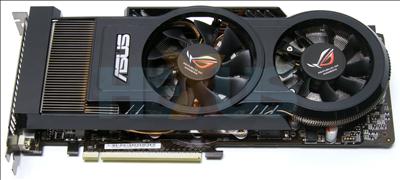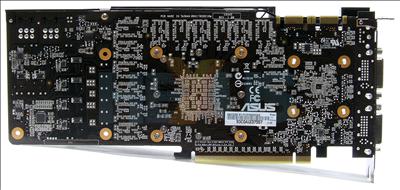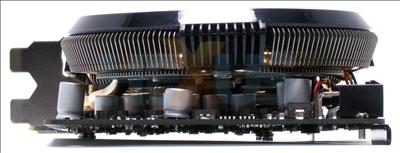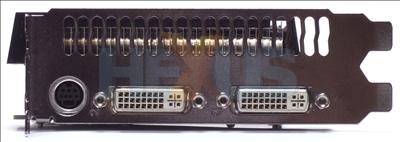ASUS GeForce GTX 260 MATRIX
ASUS already has six GeForce GTX 260 GPUs, ranging from the stock-clocked version through to the pre-overclocked 'TOP' model, so why the need for another one?ASUS may have stuck with the reference cooling on the Voltage Tweak HD 4890 but has a grounds-up design for the GeForce GTX 260 MATRIX card - part of the Republic of Gamers range. It's different enough to be worthwhile of closer attention.
The card features what ASUS terms an 'Hybrid Cooler+' heatsink that takes in two fans and more fins than you can shake a stick at.
Much like the HD 4890 VT, this card is bundled with the customised software that permits you to change, within warranty, the GPU voltage from 0.8V to 1.4V. The memory voltage, too, can be user-changed from 1.80V to 2.03V. They're pretty handy when you consider the card ships in the default state with 1.152V for the GPU and 1.92V for the memory.
The PCB carries an ASIC chip that calculates GPU load and modulates the fans' speed as needs be, in real time. Should load be minimal then only one fan spins up. Give it some 2,560x1,600 3D love and both can run at full speed.
Bundled with the card is the iTracker software utility that interfaces with the on-board chip. It ships with four pre-defined profiles - optimised, gaming, power-saving, and default - and clock-speeds/voltages are set by the profile. A user-defined profile can also be set once you're happy with the parameters for each field.
As standard the card ships at GeForce GTX 260 896MB default frequencies of 576MHz core, 1,242MHz shader, and 1,998MHz memory. Invoke the optimised profile and the core/shader clocks jump to 601MHz and 1,296MHz, respectively, together with a bump in the GPU voltage. The RAM stays the same, at 1,998MHz.
Power-saving mode, effective in 2D, drops the GPU and memory voltage down to 1.05V and 1.90V, respectively, but, and it's important, the dual-fan combo is rather noisy in 2D and 3D. We've seen the likes of Inno3D/Arctic Cooling ship pre-overclocked, customised cards which are significantly quieter.
After all the fun on the front, the back is fairly generic. You can add a further two cards for three-way SLI. 896MB's worth of DDR3 is arranged on the topside.
Here's a side-on shot of the beast. The cooler remains a dual-slot model. Heatpipes and fins dominate the cooling.
Don't worry about pushing the card with the iTracker software; the warranty remains intact so long as you stay under 1.4V for the core.
Power arrangement is still the same, that is, two six-pin connectors from your PSU.
The rear is pretty standard, shipping with the usual dual-link DVI ports and mini-DIN for TV-out.
Summary
Part of the enthusiast-oriented ROG range, ASUS GeForce GTX 260 MATRIX features some nifty cooling allied to comprehensive monitoring and tweaking abilities. The voltage-adjustment levels are richer than the Radeon's, and the pre-overclocked profile (optimised) gives a minor bump above default performance.









